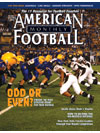AMERICAN FOOTBALL MONTHLY THE #1 RESOURCE FOR FOOTBALL COACHES
Article CategoriesAFM Magazine
|
The Speed Report: Maximizing Football Speed and Movement with A Weight Room Progby: Dale BaskettFootball Speed Specialist © More from this issue Maximizing football speed development is a year round process. This is the case at the collegiate and professional level. The high school level is not as consistent with the application towards speed development as the upper levels of football. Most high schools cannot employ full-time strength and conditioning coaches. College and pro strength coaches utilize many essentials that cover strength and speed development aspects on a year-round time table. Many high schools across our nation are trying to follow the procedural structure of this thinking. I would like to bring to light the most important aspect of speed training for football at all levels: coordinating the lifting cycle with speed and movement. Improper coordination of both training cycles can be a physiological train wreck for speed production. I would like to intr....The full article can only be seen by subscribers. Subscribe today!
|
|
|||||||
| HOME |
MAGAZINE |
SUBSCRIBE | ONLINE COLUMNISTS | COACHING VIDEOS |
Copyright 2026, AmericanFootballMonthly.com
All Rights Reserved





